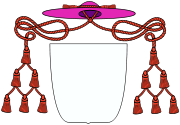
Monsignor
Encyclopedia
Monsignor, pl. monsignori, is the form of address for those members of the clergy
of the Catholic Church holding certain ecclesiastical honorific
titles. Monsignor is the apocopic
form of the Italian
monsignore, from the French
mon seigneur, meaning "my lord". It is abbreviated Mgr, Msgr, or Mons..
As a form of address, "Monsignor" is not itself an appointment (properly speaking, one cannot be "made a monsignor" nor can one be "the monsignor of a parish").
The three awards or offices most often associated with the style "monsignor" are Protonotary Apostolic
, Honorary Prelate
, and Chaplain of His Holiness
. These awards are granted by the Pope
, usually at the request of the local bishop.
or patriarch
, including bishops and archbishops. In other countries, particularly English-speaking ones, it is not used for bishops, but only for priests who have received certain specific honorary awards or who hold certain offices.
The written form of address for a priest-monsignor is Monsignor (first name) (last name) or The Reverend Monsignor (first name) (last name). The spoken form of address is Monsignor (last name).
Before the simplification of ecclesiastical titles in 1969, those of the lowest class were addressed in English as The Very Reverend Monsignor (in Latin, Reverendissimus Dominus; in Italian, Reverendissimo Monsignore) and those belonging to the higher classes were addressed as The Right Reverend Monsignor (in Latin, Illustrissimus et Reverendissimus Dominus; in Italian, Illustrissimo e Reverendissimo Monsignore)
The 1969 Instruction of the Secretariat of State indicated that the title of "Monsignor" may be used for Bishops. This is normal practice in Italian, French and Spanish. It is unusual in English. The same instruction indicated that, in the case of Bishops, "Reverendissimus" (usually translated in this case as "Most Reverend", rather than "Very Reverend"), may be added to the word "Monsignor", as also in the case of prelates without episcopal rank who head offices of the Roman Curia
, judges of the Rota
, the Promotor General of Justice and the Defender of the Bond of the Apostolic Signatura
, the Apostolic Protonotaries "de numero", and the four Clerics of the Camera.
 Pope Paul VI's motu proprio
Pope Paul VI's motu proprio
Pontificalis Domus
of 28 March 1968 simplified the classification of monsignori or lesser prelates. Previously they were divided into at least 14 different grades, including domestic prelates, four kinds of protonotaries apostolic
, four kinds of papal chamberlains, and at least five types of papal chaplains.
Since 1968, Apostolic Protonotaries are classified either de numero or supernumerary. Most of the former classes of Chamberlains and Chaplains have been abolished, leaving only a single class of "Chaplains of His Holiness", a specifically priestly-sounding category.
 As a result monsignori are now classed into the following three ranks, in descending order of precedence:
As a result monsignori are now classed into the following three ranks, in descending order of precedence:

For the history of each of these classes of monsignori, see the article on each.
Before 1968, the appointment of a Privy Chamberlain expired at the death of the Pope who granted it. This no longer holds. Those listed in the index of the Annuario Pontificio as Chaplains of His Holiness continue to be listed in the edition that follow the death of the Pope, as after the deaths of Popes Paul VI and John Paul I in 1978 and after that of Pope John Paul II in 2005.
, vicars general
and vicars capitular
(the latter are now called diocesan administrators) are titular (not actual) Protonotaries durante munere, i.e. as long as they held those offices, and so are entitled to be addressed as Monsignor.
The only privileges of dress that Pope Pius X granted them were a black silk fringed sash, black piping on the biretta with a black tuft, and a black mantelletta
. As a result of this they were in some countries referred to as "black protonotaries." However, "Pontificalis domus" of Paul VI removed this position from the Pontifical Household, even though the title of "monsignor", which is to be distinguished from a prelatial rank, has not been withdrawn from vicars general, as can be seen, for instance, from the placing of the abbreviated title "Mons." before the name of every member of the secular (diocesan) clergy listed as a vicar general in the Annuario Pontificio
. (Honorary titles such as that of "Monsignor" are not considered appropriate for religious.)
The Secretariat of State has set minimum qualifications of age and priesthood for the appointment of Chaplains of His Holiness (35 years of age and 10 of priesthood), Honorary Prelates (45 of age and 15 of priesthood) and Protonotaries Apostolic Supernumerary (55 of age and 20 of priesthood). However, it waives the minimum age limit for vicars general proposed for appointment as Honorary Prelates, in view of the fact that, as long as they hold the office of vicar general, they also hold the still higher rank of Protonotary Apostolic Supernumerary. For the same reason, the Secretariat of State does not consider it appropriate that someone who is already a vicar general be appointed only a Chaplain of His Holiness.
Clergy
Clergy is the generic term used to describe the formal religious leadership within a given religion. A clergyman, churchman or cleric is a member of the clergy, especially one who is a priest, preacher, pastor, or other religious professional....
of the Catholic Church holding certain ecclesiastical honorific
Honorific
An honorific is a word or expression with connotations conveying esteem or respect when used in addressing or referring to a person. Sometimes, the term is used not quite correctly to refer to an honorary title...
titles. Monsignor is the apocopic
Apocope
In phonology, apocope is the loss of one or more sounds from the end of a word, and especially the loss of an unstressed vowel.-Historical sound change:...
form of the Italian
Italian language
Italian is a Romance language spoken mainly in Europe: Italy, Switzerland, San Marino, Vatican City, by minorities in Malta, Monaco, Croatia, Slovenia, France, Libya, Eritrea, and Somalia, and by immigrant communities in the Americas and Australia...
monsignore, from the French
French language
French is a Romance language spoken as a first language in France, the Romandy region in Switzerland, Wallonia and Brussels in Belgium, Monaco, the regions of Quebec and Acadia in Canada, and by various communities elsewhere. Second-language speakers of French are distributed throughout many parts...
mon seigneur, meaning "my lord". It is abbreviated Mgr, Msgr, or Mons..
As a form of address, "Monsignor" is not itself an appointment (properly speaking, one cannot be "made a monsignor" nor can one be "the monsignor of a parish").
The three awards or offices most often associated with the style "monsignor" are Protonotary Apostolic
Protonotary apostolic
In the Roman Catholic Church, protonotary apostolic is the title for a member of the highest non-episcopal college of prelates in the Roman Curia or, outside of Rome, an honorary prelate on whom the pope has conferred this title and its special privileges.-History:In later antiquity there were in...
, Honorary Prelate
Honorary Prelate
An Honorary Prelate of His Holiness is a priest to whom the Pope has granted this title. They are addressed as Monsignor and have certain privileges as regards ecclesiastical dress...
, and Chaplain of His Holiness
Chaplain of His Holiness
A Chaplain of His Holiness is a priest to whom the Pope has granted this title. They are addressed as Monsignor and have certain privileges, such as regards ecclesiastical dress....
. These awards are granted by the Pope
Pope
The Pope is the Bishop of Rome, a position that makes him the leader of the worldwide Catholic Church . In the Catholic Church, the Pope is regarded as the successor of Saint Peter, the Apostle...
, usually at the request of the local bishop.
Title and forms of address
In some countries, Monsignor (or its foreign language equivalent) is the usual style of address for all higher prelates of the Roman Church below the rank of cardinalCardinal (Catholicism)
A cardinal is a senior ecclesiastical official, usually an ordained bishop, and ecclesiastical prince of the Catholic Church. They are collectively known as the College of Cardinals, which as a body elects a new pope. The duties of the cardinals include attending the meetings of the College and...
or patriarch
Patriarch
Originally a patriarch was a man who exercised autocratic authority as a pater familias over an extended family. The system of such rule of families by senior males is called patriarchy. This is a Greek word, a compound of πατριά , "lineage, descent", esp...
, including bishops and archbishops. In other countries, particularly English-speaking ones, it is not used for bishops, but only for priests who have received certain specific honorary awards or who hold certain offices.
The written form of address for a priest-monsignor is Monsignor (first name) (last name) or The Reverend Monsignor (first name) (last name). The spoken form of address is Monsignor (last name).
Before the simplification of ecclesiastical titles in 1969, those of the lowest class were addressed in English as The Very Reverend Monsignor (in Latin, Reverendissimus Dominus; in Italian, Reverendissimo Monsignore) and those belonging to the higher classes were addressed as The Right Reverend Monsignor (in Latin, Illustrissimus et Reverendissimus Dominus; in Italian, Illustrissimo e Reverendissimo Monsignore)
The 1969 Instruction of the Secretariat of State indicated that the title of "Monsignor" may be used for Bishops. This is normal practice in Italian, French and Spanish. It is unusual in English. The same instruction indicated that, in the case of Bishops, "Reverendissimus" (usually translated in this case as "Most Reverend", rather than "Very Reverend"), may be added to the word "Monsignor", as also in the case of prelates without episcopal rank who head offices of the Roman Curia
Roman Curia
The Roman Curia is the administrative apparatus of the Holy See and the central governing body of the entire Catholic Church, together with the Pope...
, judges of the Rota
Sacra Rota Romana
The Tribunal Apostolicum Rotae Romanae — also called the Sacred Roman Rota, and anciently the Apostolic Court of Audience — is the highest appellate tribunal of the Roman Catholic Church, with respect to both Latin-rite members and the eastern-rite members and is, with respect to judicial trials...
, the Promotor General of Justice and the Defender of the Bond of the Apostolic Signatura
Apostolic Signatura
The Supreme Tribunal of the Apostolic Signatura is the highest judicial authority in the Catholic Church...
, the Apostolic Protonotaries "de numero", and the four Clerics of the Camera.
Classes of monsignori

Motu proprio
A motu proprio is a document issued by the Pope on his own initiative and personally signed by him....
Pontificalis Domus
Pontificalis Domus
The apostolic letter motu proprio Pontificalis Domus was issued by Pope Paul VI on March 28, 1968, in the fifth year of his pontificate. Its purpose was the reorganization of the Papal Household, which had been known as the Papal Court before the promulgation of the letter.-Introduction:Paul VI...
of 28 March 1968 simplified the classification of monsignori or lesser prelates. Previously they were divided into at least 14 different grades, including domestic prelates, four kinds of protonotaries apostolic
Protonotary apostolic
In the Roman Catholic Church, protonotary apostolic is the title for a member of the highest non-episcopal college of prelates in the Roman Curia or, outside of Rome, an honorary prelate on whom the pope has conferred this title and its special privileges.-History:In later antiquity there were in...
, four kinds of papal chamberlains, and at least five types of papal chaplains.
Since 1968, Apostolic Protonotaries are classified either de numero or supernumerary. Most of the former classes of Chamberlains and Chaplains have been abolished, leaving only a single class of "Chaplains of His Holiness", a specifically priestly-sounding category.

- Apostolic ProtonotaryProtonotary apostolicIn the Roman Catholic Church, protonotary apostolic is the title for a member of the highest non-episcopal college of prelates in the Roman Curia or, outside of Rome, an honorary prelate on whom the pope has conferred this title and its special privileges.-History:In later antiquity there were in...
, of which two types are retained:- de numero (the highest and least common form, customarily only seven)
- supernumerary (the highest grade of monsignor found outside Rome)

- Honorary PrelateHonorary PrelateAn Honorary Prelate of His Holiness is a priest to whom the Pope has granted this title. They are addressed as Monsignor and have certain privileges as regards ecclesiastical dress...
of His Holiness (formerly "Domestic Prelate") - Chaplain of His HolinessChaplain of His HolinessA Chaplain of His Holiness is a priest to whom the Pope has granted this title. They are addressed as Monsignor and have certain privileges, such as regards ecclesiastical dress....
(formerly "Supernumerary Privy Chamberlain")
For the history of each of these classes of monsignori, see the article on each.
Before 1968, the appointment of a Privy Chamberlain expired at the death of the Pope who granted it. This no longer holds. Those listed in the index of the Annuario Pontificio as Chaplains of His Holiness continue to be listed in the edition that follow the death of the Pope, as after the deaths of Popes Paul VI and John Paul I in 1978 and after that of Pope John Paul II in 2005.
Ecclesiastical dress
The 1969 Instruction of the Secretariat of State also simplified the dress of monsignori.- Chaplains of His Holiness use a purple-trimmed black cassock with purple sash for all occasions.
- Honorary Prelates use a red-trimmed black cassock with purple sash for all occasions. The red is the same shade as that used by bishops. They may use a purple cassock as their choir dress for liturgical events of special solemnity.
- Supernumerary Apostolic Protonotaries dress the same as Honorary Prelates. As an additional privilege, they have the option of also using a purple ferraiuolo, a silk cape worn with the red-trimmed black cassock for non-liturgical events of special solemnity (for instance, graduations and commencements).
- Apostolic Protonotaries de numero (and other superior prelates of the offices of the Roman curia who are not bishops and who, as indicated above, may be addressed as Most Reverend Monsignor) have the same dress as other Apostolic Protonotaries, but wear the mantellettaMantellettaA mantelletta, Italian diminutive of Latin mantellum 'mantle', is a sleeveless, knee-length, vest-like garment, open in front, with slits instead of sleeves on the sides, fastened at the neck, once even more common than the mozzetta.-History:...
in choir and a black birettaBirettaThe biretta is a square cap with three or four peaks or horns, sometimes surmounted by a tuft. Traditionally the three peaked biretta is worn by Roman Catholic clergy and some Anglican and Lutheran clergy. The four peaked biretta is worn as academic dress by those holding a doctoral degree from a...
with a red tuft. They are thus called prelati di mantelletta (prelates of the mantelletta) because of this distinctive item of dress.
Other monsignori
Under legislation of Pope Pius XPope Pius X
Pope Saint Pius X , born Giuseppe Melchiorre Sarto, was the 257th Pope of the Catholic Church, serving from 1903 to 1914. He was the first pope since Pope Pius V to be canonized. Pius X rejected modernist interpretations of Catholic doctrine, promoting traditional devotional practices and orthodox...
, vicars general
Vicar general
A vicar general is the principal deputy of the bishop of a diocese for the exercise of administrative authority. As vicar of the bishop, the vicar general exercises the bishop's ordinary executive power over the entire diocese and, thus, is the highest official in a diocese or other particular...
and vicars capitular
Vicar capitular
A diocesan administrator is a provisional ordinary of a Roman Catholic particular church. The college of consultors elects an administrator within eight days after the see is known to be vacant. The college must elect as administrator a priest or bishop at least 35 years old...
(the latter are now called diocesan administrators) are titular (not actual) Protonotaries durante munere, i.e. as long as they held those offices, and so are entitled to be addressed as Monsignor.
The only privileges of dress that Pope Pius X granted them were a black silk fringed sash, black piping on the biretta with a black tuft, and a black mantelletta
Mantelletta
A mantelletta, Italian diminutive of Latin mantellum 'mantle', is a sleeveless, knee-length, vest-like garment, open in front, with slits instead of sleeves on the sides, fastened at the neck, once even more common than the mozzetta.-History:...
. As a result of this they were in some countries referred to as "black protonotaries." However, "Pontificalis domus" of Paul VI removed this position from the Pontifical Household, even though the title of "monsignor", which is to be distinguished from a prelatial rank, has not been withdrawn from vicars general, as can be seen, for instance, from the placing of the abbreviated title "Mons." before the name of every member of the secular (diocesan) clergy listed as a vicar general in the Annuario Pontificio
Annuario Pontificio
The Annuario Pontificio is the annual directory of the Holy See. It lists all the popes to date and all officials of the Holy See's departments...
. (Honorary titles such as that of "Monsignor" are not considered appropriate for religious.)
The Secretariat of State has set minimum qualifications of age and priesthood for the appointment of Chaplains of His Holiness (35 years of age and 10 of priesthood), Honorary Prelates (45 of age and 15 of priesthood) and Protonotaries Apostolic Supernumerary (55 of age and 20 of priesthood). However, it waives the minimum age limit for vicars general proposed for appointment as Honorary Prelates, in view of the fact that, as long as they hold the office of vicar general, they also hold the still higher rank of Protonotary Apostolic Supernumerary. For the same reason, the Secretariat of State does not consider it appropriate that someone who is already a vicar general be appointed only a Chaplain of His Holiness.

